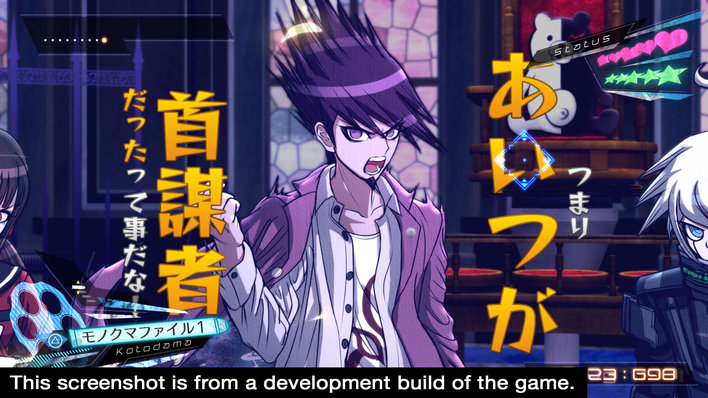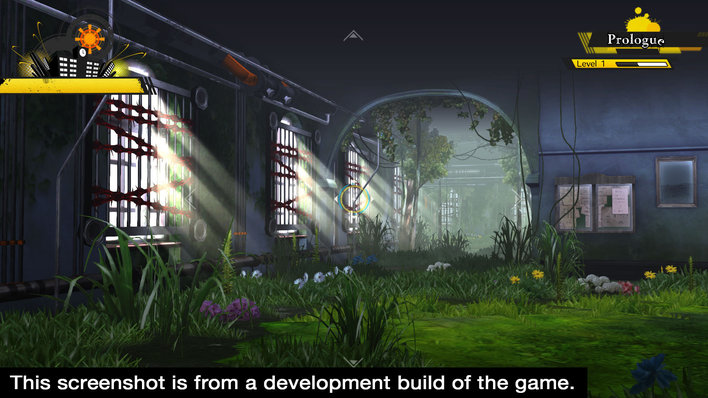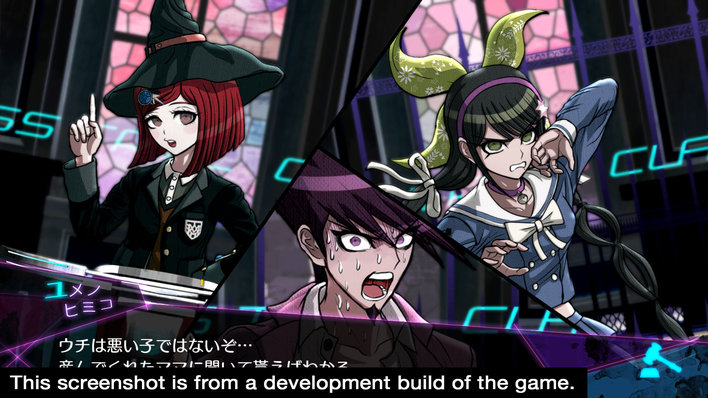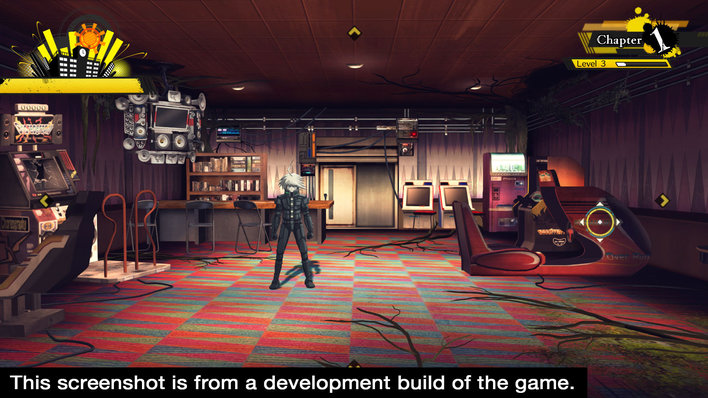Having long been a cult classic in Japan, Danganronpa first made waves on these shores back in 2014, when Danganronpa: Trigger Happy Havoc hit the Vita, and instantly captured our hearts. An incredibly tense, and equally inventive visual-novel-cum-detective-game, Danganronpa stood out from almost everything else thanks to its unique setting, fantastic cast of characters, and a tight, twisting plot line that was all but guaranteed to keep you up until the early hours of the morning, as you just had to know what happened next.
And while each Danganronpa game has had a different setting and cast, they all have a kind of similar plot. Telling the story of a group of teenage "Ultimates" - each the very best the country has to offer at their chosen profession - what starts out as a high school drama quickly takes a turn for the murderous, when a cute/sinister teddy bear named Monokuma pops up to reveal the deadly truth. What they thought was a school turns out to be a prison, with Monokuma set to keep them prisoners for the rest of their lives. Of course, Monokuma isn't a totally sadistic bear, and there is still a way the students can escape - all they have to do is murder one of their classmates, and then not get caught out during the "class trial" that follows. Giving you chance to examine the scene of the crime, before all coming together to attempt to figure out what happened, and whodunnit, it's up to you to use the evidence you've gathered (represented in game as "truth bullets"), and use them to fire at the weak spots in your opponents statements, cutting through the lies to get to the bottom of who the guilty party is. Get it right, and the murderer will be executed, letting the rest of the class live on. Get it wrong, and the murderer will walk free, while the rest of the school get put to death. Nothing to worry about then, right?
At a recent event in London, we got the chance to sit down with Kazutaka Kodaka, a man who's essentially "Mr Danganronpa", to talk all about the series, and the latest instalment, Danganronpa V3, which is out on the 29th September on these shores. This time set in a school for the Ultimate Delinquents (which on its own sounds like a recipe for disaster), V3 brings together another eclectic cast, only for the dastardly Monokuma to pop up, imprison them, and force them to murder each other if they ever want to escape. As the first Danganronpa game to have a female protagonist - the Ultimate Pianist, Kaede Akamatsu - you'll be getting to know a collection of classmates that are as weird and wacky as you might imagine, including the Kaito Momota, the Ultimate Astronaut, K1-B0, the Ultimate Robot, and Gonta Gokuhara, Ultimate Entomologist (or, insect guy, to you and me) - a man who got himself lost in a forest for a decade, ended up being raised by wolves, and learnt to speak to animals and insects alike. As you do.

The orange sections are potential weaknesses in each classmate's argument. It's up to you to choose the right truth bullet to break through it. (Of course, it'll be in English when it launches over here)
As with the earlier Danganronpa games, these ultimate abilities aren't simply chosen by random. Instead, Kodaka-san and his team spend weeks going over each character, trying to come up with the very best abilities that'll fit into the storyline, fit with the characters, and give them plenty of material to play with in the murders. As you'll quickly find when you pick up a Danganronpa game, nothing - and we mean nothing - is ever as it seems. A mystery game at heart, Danganronpa never fails to surprise, and it's constantly setting up traps to try and lure you in - if there's a rule, it's probably only there to catch you out; if you think you've figured out whodunnit, chances are there'll be a dozen or so twists before you actually collar the guilty party, as Kodaka-san explained. "It's really important to keep the characters distinctive and unique, because without that, players might not have that emotional connection. But what we really focus on is betraying the player. In other words, what can we do that'll give the player the biggest shock and surprise. Recently, people have come to the conclusion that Danganronpa's all about the characters, but that's not how we see it. Instead, it's a vehicle to surprise players - getting them to expect one thing, only to turn it all around on them. And V3 definitely has the biggest surprises waiting."

The ultimate delinquents academy has been let go to rack and ruin...
But while it may have a similar sounding plot, you may be surprised to learn that V3 has apparently been designed as more of a stand alone game, rather than a continuation of the series as a whole. Designed to be easy to pick up and play, whether you've played the previous games or not, Kodaka-san assured us that the plot of V3 will have nothing to do with the previous games, and that Monokuma was the only returning character - but whether that's a red herring in and of itself remains to be seen...
For V3, the class trials have been shaken up a bit too. While the winning formula from the previous games hasn't been tweaked too much, a few new features have been added in to spice up the mix. In each trial, you'll still sit through a repeating round of statements, as your classmates offer their thoughts (and lies) on the issue, until you can expose the holes in their arguments - but this time around, you'll need to employ some different strategies if you want to catch them out, as Kodaka-san elaborates, "[Essentially, V3] is all about lying - and that theme's even been implemented into the class trials. Sometimes, there'll be times where in order to proceed, you actually have to take one of your truth bullets and make it the opposite of what it is - essentially turning it into a lie - in order to proceed."

When things heat up, several characters may start talking at once...
Sticking with our no spoiler philosophy, the best example of this probably comes from the stand-alone demo that's due to be released any time now. With each trial having been designed to lead you down a specific path, sometimes, you'll realise that your classmates are all barking up the wrong tree. But whereas before, you needed evidence to shatter your friends' misconceptions, now can you simply turn some of your evidence into a lie. At one point in the demo, the class begins to suspect Makoto (the protagonist from the original game, whose special cameo is limited to the demo), but V3 protagonist Kaede is convinced it can't be him. The problem is, Makoto's the only person without an alibi - but thanks to the new lying ability, you still have a way to get everyone to go down the right path. Selecting the "Missing Makoto" truth bullet and pressing Triangle will let you turn it into a lie, creating a bullet that lets you cover Makoto's back by telling the class he was with you the whole time. It might not be true - but as no-one else can prove you wrong, you can shepherd the class down the road you want them to take, as you start to unravel the truth.
While visual novels may be hugely popular in Japan, though, the choose-your-own-adventure style games are still an uncommon fixture over here. Danganronpa has really been one of the few to make it "big", becoming a success in both the West and Japan, without having to really adapt itself for the differences between the two audiences. Kodaka-san even went as far as to call Danganronpa is really his very own "dojin" game - a game which is essentially a fan project, built out of passion alone, rather than specifically trying to tick boxes and meet market needs - a factor he believes played a large part in its success. "When we were developing the original Danganronpas back on the PSP, that was a time when visual novels weren't selling very well. So we set out to make it as not-like a visual novel as possible, while still keeping it a visual novel. If we hadn't done that, people might not have even looked at the game. If you look at the rooms, there's practically no 2D here - everything is 3D modelled, which is unusual for a visual novel"

In free time (and after a murder occurs), you'll get to explore the run down school where you're being held prisoner, looking for clues, chatting with your classmates, and looking for a way out
Accessibility, too, has always been a key issue for the titles. "Especially in Japan, it's common for people who don't necessarily play lots of games to enjoy the Danganronpa games", Kodaka-san told us, which is why Danganronpa V3 will have two difficulty levels, as with the previous games in the series. One setting lets you adjust the difficulty of the puzzles, while the other lets you set the difficulty of the "action" sequences - like having to blast "noise" statements during the class trials, to clear the way for your truth bullets.
As the first game in the series to be developed primarily for the PS4, long time fans may also be pleased to know that the game will still be hitting the Vita, and will achieve feature parity with its home console big brother. "Taking it down from the PS4 to the Vita was very, very difficult. [But] as I've heard lots of people went out in Japan to buy Vitas especially for Danganronpa, we kind of felt like we *had* to do a Vita version", Kodaka-san explained.
Impressively, it turns out there's more to Danganronpa V3 than just the main game, too. Once you finish the main story, you'll actually unlock a full on Danganronpa role playing game, complete with returning characters from Danganronpa 1 and 2 - a bonus that goes way beyond the "school mode" time management mini-games you'd unlock at the end of the first two games, essentially making V3 two games in one - something which Kodaka-san says speaks volumes about their philosophy, "The whole idea is to make something we love and want to do. The RPG mode, honestly speaking, is something we could have sold separately - and if we really wanted to go over the top, we could have made certain characters DLC too. But that isn't what I wanted to do, that isn't the sort of game I wanted to make."
Instead, the type of game Kodaka-san wants to make is one that'll keep you up until the early hours of the morning, as much like a good book, you can't stop playing, because you want to see what happens next, who dies next, and what twists the story has in store. One by one, more and more murders will happen, as the classmates start to lose their mind, being driven to kill by the sadistic humour of Monokuma. And although Monokuma may look cute and cuddly now, that hasn't always been the way. In fact, the original concept art shows something very different indeed.

Nope nope nope nope
And if that doesn't give you nightmares, we don't know what would. Although Monokuma can be a bit of a scumbag himself, at least he hasn't got half of his skin missing - so we asked if there was an interesting story behind the concept art, and why the game made the switch from the pure nightmare fuel pictured above. "From the beginning, we wanted to have this idea of black and white, two separate halves of something. First of all we tried to make it a human, so our character designer drew a human Monokuma, but I thought something cute would be better. So we turned it into a bear. The whole theme of Danganronpa is psycho-pop. If we kept the human, we'd have lost the pop and it'd just be pyscho...". Too right.
With a demo due to launch in the next few weeks, it won't be long before you get to delve under the skin of Danganronpa V3 for yourselves. With a great cast of ultimates in place, the same winning murder-mystery class trial gameplay, a foreboding atmosphere like no other, and plenty of red herrings promised, you can be sure of a story like no other. As Kodaka-san himself puts it, "from the characters, to the design, to what happens in the murders, to their skills and ultimates, anything and everything about everything is designed to mislead the player, take them down one road, but bring them somewhere else."
The one thing you can be sure about is that the game launches on the 29th September on the PS Vita and PS4 in the UK and Europe. For more on Danganronpa, be sure to check out our reviews of PS Vita "Must Buy" Danganronpa: Trigger Happy Havoc (a game that's honestly so, so good, if you don't already have a Vita, you should buy one just for this), its ever so slightly underwhelming sequel Danganronpa 2: Goodbye Despair, and shooter spin-off Danganronpa: Ultra Despair Girls.


















